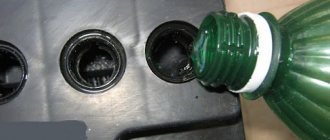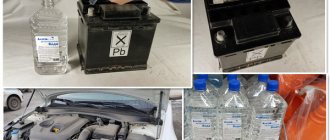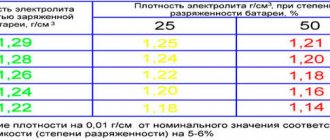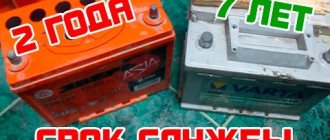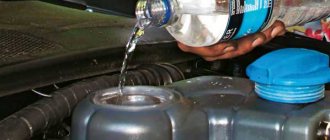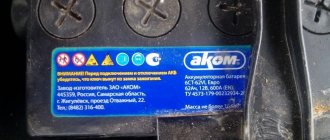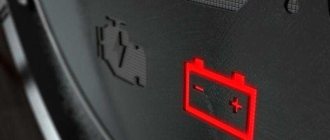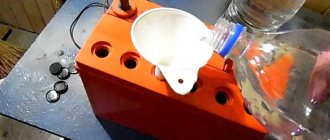If you do not monitor the electrolyte level, premature destruction of the battery plates begins. At the same time, you cannot overfill the water either - then the battery capacity drops, and in winter there is a risk of the electrolyte freezing.
You need to add distilled water to a level of 1.5-2 centimeters above the edge of the plates or 0.5 cm above the special indicator (“reeds”). The goal is to achieve a battery electrolyte density of 1.27 g/cm³ .
Do you know the correct level of electrolyte in the battery, how to determine it, how to maintain it at the required level, what to add and how to do it? No - then read the article.
Purpose of distilled water
Distilled water is an important component in the liquid of a car battery, ensures its full functionality, maintains the desired density of the electrolyte, which contains 65%. And the percentage of sulfuric acid is only 35%.
Sulfuric acid is a fairly highly concentrated chemical compound that, in its pure form, poses a danger to the battery. To reduce its concentration, purified water is needed. The ratio Н2О/H2SO4 = 65/35 ensures the accumulation of electrical energy at the time of charging the battery, which is subsequently used to start and move the vehicle.
Distilled water (DV) is ordinary water purified from organic compounds (waste products of plants and animals, bacteria, viruses) and inorganic impurities (salts, mineral additives, other substances). It consists of two chemical elements: hydrogen (H) and oxygen (O).
Before you find out how much distilled water to add to the battery, it is important to understand that ordinary water is not suitable for such a procedure. It contains a large number of different impurities (salts, chlorine, lime and others), which contribute to the rapid failure of the car battery. You cannot pour boiled water into the battery, since ordinary boiling does not distill (purify) the liquid in full.
Why is no electrolyte used?
During the operation of the battery, especially in the summer, the battery heats up, as a result of which the jars may boil. The DW evaporates at this moment. Acid is a non-volatile liquid; accordingly, it remains and the concentration of water decreases. The density of the mixture sometimes increases to 1.4 g/cm 3 . Therefore, in order to bring the electrolyte to normal density, it is necessary to add DV.
If you pour electrolyte, the density will decrease, but not enough.
It is important to remember about salt precipitation and destruction of the plates. Therefore, in order to reduce the density of the liquid to the established norm, only DV is added. This rule must always be remembered!
It is also worth remembering that water is added only to batteries of the type being serviced, which are characterized by maximum evaporation. Maintenance-free batteries are equipped with a molded sealed case; the evaporated liquid does not come out, it precipitates inside the can. In this case, a closed cycle occurs; there is no need to add water.
Is it possible
| You can charge a maintenance-free battery outside the car. |
With the onset of winter, low temperatures thicken the lubricant in the engine, making it more difficult for the starter to spin it - more energy is wasted, and more starting current is required. And if your maintenance-free battery usually runs, say, half charged, and that was enough, then in winter, after one or two unsuccessful attempts to start the engine, the starter will simply stop turning. Charging a maintenance-free car battery is a must when winter sets in. It needs to be brought to a 100% charge level and then you can leave the garage more calmly.
When is battery refilling required?
Most experts believe that car batteries do not require maintenance. Accordingly, adding water to it is irrelevant, but provided that the battery is used under normal conditions. It is imperative to check the fluid level for motorists who travel long distances in their own cars. In this case, the probability of converting the liquid into a vapor state is greatest. And also the active process of water evaporation is carried out in the event of failure of the relay regulator.
Main indicators of failure of the relay regulator:
- during the operation of the vehicle, the battery becomes very hot;
- drops of electrolyte are observed on the battery body;
- Strong steam comes out of the filler necks.
It is necessary to take into account the design of the battery. In serviced models, much greater evaporation of H2O occurs. Therefore, it is for them that it is worth knowing how much water to add to the battery. In maintenance-free models, evaporation of liquid into the environment is prevented by a sealed cast housing. Such batteries do not require additional maintenance.
What can be replaced?
If distilled water is not available, and the battery is needed in the near future, you can use the following liquids:
- Water formed when freezer ice melts.
- Condensation from climate control systems.
- Homemade option.
When choosing a source as a replacement, it is important to pay attention to its purity.
For example, snow and rain are unlikely to correspond to the level of purification of technical distillate. Also, do not take boiled water.
Checking the electrolyte level
The presence of electrolyte is checked exclusively in serviced batteries. They are most often equipped with a transparent body, so inspection is carried out visually. For this purpose, special marks are made on the surface corresponding to a certain volume of liquid.
Serviceable batteries with an opaque casing are also available. To determine to what level to add water to the battery in this case, the vehicle owner will need a special transparent tube with a diameter of 0.5 cm.
Fluid level check sequence:
- The battery cover is unscrewed;
- the transparent tube is lowered into the liquid, and it should rest against the bottom of the jar;
- its outer hole is clamped tightly with a finger;
- it is then removed from the battery to determine the electrolyte level.
Such a tube has minimum and maximum divisions. Accordingly, if the accumulated liquid is within these limits, the volume of electrolyte is normal. If the fluid is below the minimum, you need to add DV.
Features of servicing Mutlu, Bear, Beast 60 Ah and Varta devices
For ease of maintenance, Mutlu brand batteries are equipped with a charging and charging indicator.
The characteristic state of the device corresponds to its color:
If the color is yellow or white, refilling with distillate is required. It is entirely carried out according to the mechanism discussed above.
battery with a capacity of 60 Ah also has a charging indicator and electrolyte level with the following characteristics:
- Green – charged.
- White – low density, requires charging.
- Red – electrolyte refilling is required.
When the indicator color is red, it is necessary to top up the battery with distilled water according to the scheme discussed above.
Bear and Warta batteries are filled as standard. In addition, the manufacturer Varta has released a special refilling container that can be inserted into six cans at once.
How to add fluid correctly
If the density of the electrolyte in a car battery has increased or the battery does not provide the required voltage, then the reason is evaporation of the active substance. According to the norm, the electrolyte consists of: H2SO4 (sulfuric acid) - 35%; H2O - 65%.
Instructions for adding fluid to the battery:
- The upper surface of the battery is cleaned of dirt and thoroughly wiped, especially near the plugs.
- While charging the battery, sulfuric acid may have splashed out. Therefore, to neutralize it, the neck area must be wiped with a rag soaked in a soda solution.
- Now you need to carefully unscrew the plugs. It is recommended to wear gloves to protect your hands from the electrolyte.
- Using a medical syringe, DV is drawn up and poured into jars where the liquid level has dropped.
- The plugs are screwed in.
- After 2 hours, it is necessary to check compliance with the electrolyte density standards using a special device - a hydrometer. If the indicators are normal, the battery can be charged.
Add liquid only on a horizontal surface, otherwise the level will show the wrong volume. It is also worth considering the fact that the density of the electrolyte differs in different climatic conditions. For example, in Russia:
- in the south of the country - 1.25 g/cm3;
- in the central regions - 1.27 g/cm3;
- in the northern territories - 1.29 g/cm3.
To accurately measure the density of a liquid, the hydrometer must be strictly in a free state, in a vertical position and not in contact with the walls of the container. Having carefully lowered the hydrometer into the liquid, you need to wait until it completely stops oscillating, then take readings on the scale at the point of its intersection with the surface of the electrolyte. This is the density of the liquid.
Obtaining distillate at home
There are motorists who do not go to the store for DV. They produce it themselves at home. This is mainly the older generation, who lived through times of shortage, and people living in settlements remote from the city, where many products simply do not arrive.
If you want to prepare DV yourself, you should understand that it will not be of high quality, since for this you need to have special expensive equipment - a distiller. But as an alternative, a regular moonshine still without a coil is suitable. The productivity of the DV when using this option will be approximately 1 glass in 3-4 hours.
The formula of distilled water is H2O. A high-quality liquid should not contain foreign impurities. It is impossible to achieve such a result under domestic conditions; a small content of metal salts will still remain.
Recommendations:
- If you urgently need to add water to the battery, you can take it from the tap into a plastic bottle and put it in the freezer for 2-3 hours. You should only use ice that has been melted beforehand. Unfrozen water is drained into the sink. The DV obtained in this way will cause minimal damage to the battery.
- Another way is to collect rainwater in a plastic container, carefully filter it, and then use it for its intended purpose.
Important! The collected water for the battery should not come into contact with iron objects. For example, water running off the metal roof of a house is not suitable for this purpose.
Owners of serviced car batteries need to regularly monitor the level of electrolyte in them and, if necessary, add pure H2O, free of minerals and organic additives. This water is called distilled and is an important component of the battery fluid. Its task is to maintain the chemical composition of the electrolyte at an optimal level, thereby guaranteeing high-quality battery operation.
Before you find out how to properly pour purified liquid into the battery, it is important to remember that it is prohibited to use tap or boiled water for this purpose. They contain a lot of foreign impurities (iron, calcium, magnesium, chlorine), which are deposited on the metal plates of the battery during charging. This “scale” leads to a decrease in battery capacity and destruction of its plates. This changes the density of the electrolyte in the battery.
From a pharmacy or an auto store - what and when to choose?
In fact, the distillate, both in a pharmacy and in a car dealership, is pure water with minor technical impurities. Medical products can be of two types - for injection (sterile) and for general use.
To manufacture the first modification, sterile devices are used, which naturally leads to an increase in the cost of the method and the final product. Therefore, you can buy it both at a car dealership and at a pharmacy. There is no difference between them in terms of applicability. The only thing you should pay attention to is the price tag of the product.
Find even more information about the points of sale of battery distillate at the link.
Where can I get distilled water?
Car owners can buy deeply purified water in a five-liter bottle or other container at a hardware store, supermarket (in the household appliances department), pharmacy or at a gas station in the auto cosmetics department; these outlets are supplied by trusted suppliers. The largest manufacturer and supplier of distilled water is. You can order and buy distilled water on this page. You can also get it in normal home conditions, using one of the traditional methods of cleansing.
The first method is evaporation. For it you will need a large saucepan that closes tightly with a lid, a glass container and a metal grid. A wire rack is placed in the pan and then filled halfway with plain water. The glass container is placed on the grill so that its neck rises above the water. The pan is tightly closed with a lid and put on gas. Ice is placed on top of it. The water boils, condenses on the cooled lid and is collected in a glass container.
The second method is freezing. To do this, running water is poured into a plastic bottle and placed in the freezer. After half the liquid turns into ice, the unfrozen water is drained from the bottle and the remaining ice is melted. This is the distillate.
And the easiest way is to collect rainwater, which is a natural distillate. True, in large cities it has too high a percentage of acidic impurities, which makes it unsuitable for use in a battery.
Correctly pour distilled water into the car battery
The service life of the car battery and the serviceability of the car’s electrical network depend on how correctly we pour the distillate into the car’s battery. By maintaining the sequence of actions, we thereby extend the life of the battery.
1. Place the battery strictly horizontally. Otherwise, you will either overfill the water or not add it due to the fact that there will be different levels of liquid in the jars.
2. Wipe the surface of the battery around the edges of the plugs to remove any dirt.
3. Dip a rag in the soda solution and wipe the necks of the jars with it to neutralize the sulfuric acid that has accumulated there during the charging process.
4. Unscrew the caps, trying to prevent electrolyte from getting on your hands (it is better to wear gloves).
5. Fill a small rubber bulb with purified water and carefully pour it into each jar.
6. Inspect the electrolyte level in the cans - the battery fluid should be 1 cm above the top edge of the plates.
7. Simply remove excess liquid with a pear in the required volume.
8. Screw on the caps.
9. Charge the battery no earlier than after 3-4 hours.
Why do you need topping up?
The internal environment of a battery is constantly changing. Battery fluid tends to evaporate. This is most noticeable when operating the car in hot weather.
In this case, it is the aqueous component of the electrolyte that evaporates. The remaining acid forms a more saturated solution with a reduced volume of distillate.
All this leads to an increase in the density of the electrolyte and disruption of the device. As a result, the plates are subject to increased destruction. In addition, if they are not immersed to their full height, they simply remain 100% unused.
In practice, this is revealed in the following negative processes:
- Reduced electrical capacity.
- Reducing operating time.
- A sharp reduction in battery life.
The only way to eliminate this series of problems is to add distilled water in time.
How much distilled water should be added?
The batteries of new models, made of translucent plastic, are quite easy to add water to. On their body there is a scale with the manufacturer’s recommended liquid level, which must be adhered to. The situation is more complicated with older type batteries. Here are some tips to help you cope with the task. If your battery has a small tongue below the neck of the cans (metal or plastic), then water should be added until the electrolyte level rises 5 mm above it. If there is no tongue, then you need to add distilled water until the electrolyte level rises 1 cm above the top of the plates.
And a few more important points: do not add water to the car's autonomous power supply if you have just turned off the engine. The battery must sit for several hours before it can be opened. In the same way, you cannot immediately turn on the internal combustion engine after adding distilled water to the battery. The battery must sit for at least a few hours, otherwise it may boil.
An excellent alternative to distillate is deionized water. It is purer than distilled water, more precisely 100 times more pure, and can also be used for filling into batteries.
Distilled water for batteries
The battery is an integral part of almost any modern device or car. The battery, like all components of the car, requires care and compliance with recommendations during operation - one of the rules that must be followed is monitoring the level of distilled water in the battery.
It is required for the normal passage of all chemical processes occurring in the battery. When the level drops, you can fill the battery with distilled water yourself. How to do it yourself? How much should I add? How to track the level?
Modern active vehicle safety systems
Active vehicle safety systems are aimed at preventing emergency situations and preventing accidents. The vehicle's electronic control unit is responsible for monitoring active safety systems in real time.
1.Anti-lock braking system or ABS
The car's wheels may become blocked during sudden braking and high speed driving. Controllability tends to zero and the likelihood of an accident increases sharply.
The anti-lock braking system forcibly unlocks the wheels and returns control of the car. A characteristic sign of ABS operation is the beating of the brake pedal. To increase the effectiveness of the anti-lock braking system when braking, depress the brake pedal as hard as possible.
The system avoids slipping and makes it easier to climb uphill on slippery road surfaces.
The system is aimed at ensuring vehicle stability when driving on the road. Efficient and reliable in operation.
4.Brake force distribution system or EBD
Allows you to prevent the car from skidding when braking due to the uniform distribution of braking force between the front and rear wheels.
5.Differential lock
The differential transmits torque from the gearbox to the drive wheels. The lock allows for uniform transmission of force, even if one of the drive wheels has insufficient traction with the road surface.
6.Assistance system for ascent and descent
Ensures that optimal speed is maintained when descending or ascending a mountain. If necessary, brakes one or more wheels.
7.Parking sensors
A system that simplifies parking a car and reduces the risk of collision with other vehicles when maneuvering in a parking lot. A special electronic display indicates the distance to the obstacle.
8.Preventive emergency braking system
Capable of operating at speeds over 30 km/h. The electronic system automatically monitors the distance between cars. If the vehicle ahead comes to a sudden stop and there is no reaction from the driver, the system automatically slows down the car.
Modern car manufacturers pay a lot of attention to active and passive safety systems. They are constantly working on their improvement and reliability.
How to fill
Serviced
Adding a little or pouring distilled water into the battery (being serviced) is not a problem, and it is possible to carry out the process yourself:
- You need to purchase distilled water (best at a pharmacy).
- The plugs are unscrewed so that the electrolyte and plates are visible - if the level of the mixture is below the plates, then it is necessary to fill in water with a syringe until the plates are closed (the level of electrolyte and water should exceed the plates by 1-1.5 cm).
- After adding, you need to charge the battery.
Maintenance-free
Is it possible to add distilled water to a maintenance-free battery? The answer is clear - it’s possible, but it’s more difficult to do than with the type of battery being serviced (the process is not provided by the manufacturer).
First of all, it should be noted that it is necessary to add water to a maintenance-free type battery much less frequently. This is due to the fact that batteries of this type are well sealed, and “ring technology” is used inside, which reduces evaporation to a minimum. The battery life without unnecessary manipulation is about 4-5 years.
Pouring process:
Adding distilled water to the battery
- It is necessary to determine the electrolyte level - to do this, shake the battery and determine the approximate level by sounds. When the feeling suggests that the level is normal, sulfation of the plates may have occurred and there is no point in adding water.
- It is necessary to determine the level of the plates - if the battery is not transparent, then you will have to determine it “by eye”; in other batteries you can illuminate it with a flashlight or buy batteries in a transparent case.
- An indentation is made from the plates by a maximum of 2 cm upwards, it is marked, and a hole is made with a drill (2-3 mm).
- Fill a syringe with distilled water and fill it until water begins to pour out of the hole made.
- The battery is shifted to the other side, and the holes made are sealed with a very ordinary soldering iron.
- Place it on charge and charge to full level.
The process is complex, and there are many inaccurate steps, but do not forget - the manufacturer does not provide for adding water to a maintenance-free battery!
Recommendations
- The surface on which the process takes place must be flat! For what? So that the mixture level is not distorted;
Distilled water for batteries
The process of pouring distilled water into the battery can be seen in the video.
Volume
How much distilled water should I add to the battery? What level is acceptable? It is necessary to top up until the plates disappear and are no longer visible. Translating the values into numbers, the amount of water depends on the total capacity of the battery, so you need to focus on hiding the plates with electrolyte by 1.5-2 cm. It is at this level that the required electrolyte density of 1.27 g/cm 3 is achieved.
Important: if, when adding water, the level is exceeded, the density will decrease, and there will be a possibility of the battery “freezing” in winter. When the level is exceeded, you can pump out the water using the syringe that was used to add it.
As a result, we can say that adding water to serviced batteries is an immediate necessity. The situation with maintenance-free batteries is different - it depends only on the wishes of the car owner. But in any case, you must remember that adding water is a temporary measure! After some time, it will still become unusable, and you will have to buy a new one.
After pouring, the density has dropped - what to do?
Sometimes the level of battery discharge reaches such a degree that even after bringing the electrolyte with distilled water to the required level and a full charging cycle, the density does not increase.
The only way out in this case is to drain all the liquid and fill in a new solution.
However, it should be borne in mind that this method is suitable for batteries that are still working. This method does not work on instances that have exhausted their resource. You just need to replace the battery.
